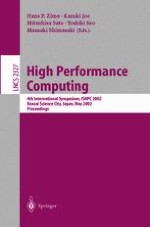I wish to welcome all of you to the International Symposium on High Perf- mance Computing 2002 (ISHPC2002) and to Kansai Science City, which is not farfromtheancientcapitalsofJapan:NaraandKyoto.ISHPC2002isthefourth in the ISHPC series, which consists, to date, of ISHPC ’97 (Fukuoka, November 1997), ISHPC ’99 (Kyoto, May 1999), and ISHPC2000 (Tokyo, October 2000). The success of these symposia indicates the importance of this area and the strong interest of the research community. With all of the recent drastic changes in HPC technology trends, HPC has had and will continue to have a signi?cant impact on computer science and technology. I am pleased to serve as General Chair at a time when HPC plays a crucial role in the era of the IT (Information Technology) revolution. The objective of this symposium is to exchange the latest research results in software, architecture, and applications in HPC in a more informal and friendly atmosphere. I am delighted that the symposium is, like past successful ISHPCs, comprised of excellent invited talks, panels, workshops, as well as high-quality technical papers on various aspects of HPC. We hope that the symposium will provide an excellent opportunity for lively exchange and discussion about - rections in HPC technologies and all the participants will enjoy not only the symposium but also their stay in Kansai Science City.
